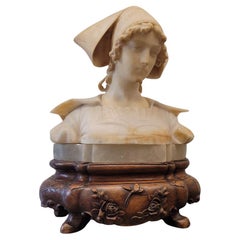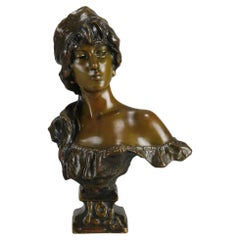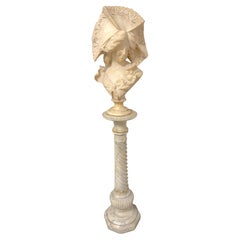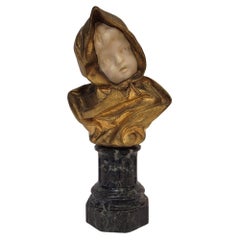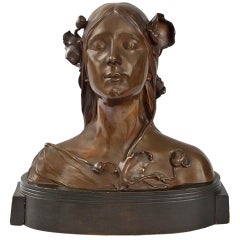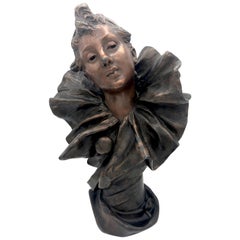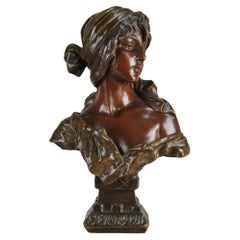Antique Art Nouveau Bust
to
49
251
170
254
254
198
146
75
47
15
13
3
1
70
14
14
5
4
Sort By
Art Nouveau Bust of a Young Lady Sculpture 1900 Latour
Located in Berlin, DE
-Art Nouveau bust
- Alabasta with marble pedestal
- Signed latour
- Good condition
Category
Early 1900s French Art Nouveau Antique Art Nouveau Bust
Materials
Alabaster
French Art Nouveau Bust of a “Breton woman” alabaster wood
By French House & Garden
Located in Valladolid, ES
Author / School: French School
Style: Art Nouveau
Period: Around 1900
Country of origin: France
Overall
Category
Early 1900s French Art Nouveau Antique Art Nouveau Bust
Materials
Alabaster
$3,500 Sale Price
20% Off
H 50 in W 34 in D 20 in
Late 19th Century Art Nouveau Bust Entitled "Lola" by Emmanuel Villanis
By Emmanuel Villanis
Located in London, GB
Stunning Art Nouveau bronze bust depicting the character "Lola" modelled in the midst of an
Category
19th Century French Art Nouveau Antique Art Nouveau Bust
Materials
Bronze
$5,248
H 28 in W 18 in D 12 in
Late 19th Century Art Nouveau Bust entitled "Silvia" by Emmanuel Villanis
By Emmanuel Villanis
Located in London, GB
Art Nouveau style, with fabulous multi hued patination of brown and a subtle green, accentuating the
Category
Late 19th Century French Art Nouveau Antique Art Nouveau Bust
Materials
Bronze
$5,108
H 11.03 in W 6.3 in D 3.94 in
Monumental Italian Carved Alabaster Art Nouveau Bust, by A. Cipriani & Pedestal
By Adolfo Cipriani
Located in West Palm Beach, FL
refinement and decorative romanticism of the Italian Art Nouveau period.
The female figure is shown in three
Category
Early 20th Century Italian Romantic Antique Art Nouveau Bust
Materials
Alabaster
$12,500 / set
H 68 in W 18 in D 12 in
French Art Nouveau Bust of a child chrysoelephantine marble, after G. de Thouin
Located in Valladolid, ES
/Workshop of G. de Thouin
Style: Art Nouveau
Material: Chrysoelephantine bust and marble column
Period
Category
Early 1900s Antique Art Nouveau Bust
Materials
Marble, Ormolu
$1,087
H 8.67 in W 4.73 in D 3.94 in
Josef Öfner Austrian Art Nouveau Bust of Ophelia
By Josef Öfner
Located in New York, NY
Austrian Art Nouveau patinated bronze bust of Ophelia by Josef O¨fner. Like the sculpture of
Category
Early 20th Century Austrian Art Nouveau Antique Art Nouveau Bust
Materials
Bronze
Art Nouveau Bust of a Pierrette Female Pierrot
Located in Munich, DE
This wonderful expressive cast of a Pierrette, a female pierrot. Has been executed in France in the last decade of the 19th century.
The sculpture is signed R. Allard.
Category
1890s French Art Nouveau Antique Art Nouveau Bust
Materials
Metal
Late 19th Century Art Nouveau Bust Entitled "Cendrillon" by Emmanuel Villanis
By Emmanuel Villanis
Located in London, GB
An attractive late 19th Century Art Nouveau French bronze bust exhibiting deep multi-hued
Category
19th Century French Art Nouveau Antique Art Nouveau Bust
Materials
Bronze
$5,598
H 11.82 in W 7.49 in D 4.73 in
French Art Nouveau Woman Bust “Fraises au Champagne” by Alfred Jean Foretay
By Alfred Jean Foretay
Located in LA CIOTAT, FR
Polychromed cast aluminium “Art Nouveau” bust of a young woman dressed in a ruffled bustier
Category
Late 19th Century French Art Nouveau Antique Art Nouveau Bust
Materials
Aluminum
$2,490
H 16.15 in Dm 8.27 in
French Antique Patinated Bronze Bust of an Elegant Woman
Located in LA CIOTAT, FR
French School with this exquisite Art Nouveau bust sculpture. A captivating bust of a woman in patinated
Category
19th Century Unknown Art Nouveau Antique Art Nouveau Bust
Materials
Bronze
Art Nouveau Woman Sculpture or Bust
Located in Hamilton, Ontario
Beautiful alabaster sculpture of an Art Nouveau lady resting on a marble plinth. Signed R. Schoggi.
Category
Early 20th Century Art Nouveau Antique Art Nouveau Bust
Materials
Alabaster, Marble
Original Tiffany Bronze Bust of a Woman Signed E. Villanis
By Emmanuel Villanis
Located in New York City, NY
with chiseled features wearing a low bodice.
The Art Nouveau bust entitled “Frinette” was sculpted by
Category
Late 19th Century French Belle Époque Antique Art Nouveau Bust
Materials
Bronze
Art Nouveau Sculpture Bust by Anton Nelson
By Anton Nelson
Located in Buenos Aires, Argentina
Art Nouveau sculpture Bust by Anton Nelson
Circa 1949-1910 Origin France
Material: zinc plated
Category
Early 1900s Art Nouveau Antique Art Nouveau Bust
Materials
Zinc
Late 19th Century Ceramic Bust entitled "Meditation" by Ernst Wahliss
By Ernst Wahliss
Located in London, GB
A beautiful late 19th Century ceramic Art Nouveau bust in muted vellum tones with gilded highlights
Category
Late 19th Century Austrian Art Nouveau Antique Art Nouveau Bust
Materials
Ceramic
$2,029
H 7.49 in W 4.34 in D 2.76 in
Antique Art Nouveau Plaster Bust by Hochock
Located in London, GB
A stunning antique bust from the Art Nouveau period. We think this is French and dates from around
Category
Late 19th Century French Art Nouveau Antique Art Nouveau Bust
Materials
Plaster
Art Nouveau Dante Alighieri Bust Antique Italy, 1900s
Located in Nuernberg, DE
Beautiful Art Nouveau bronzed colored plaster bust. Bust with lots of patina, damages, as found
Category
Early 1900s Italian Art Nouveau Antique Art Nouveau Bust
Materials
Plaster
Art Nouveau Bronze Bust "Lucrece” by E Villanis
By Emmanuel Villanis
Located in London, GB
A entrancing late 19th century French Art Nouveau bronze bust entitled ‘Lucrece’, of a beautiful
Category
Late 19th Century French Art Nouveau Antique Art Nouveau Bust
Materials
Bronze
An Art Nouveau Marble Bust of a Young Girl
Located in Catania, Sicilia
This captivating Art Nouveau marble bust portrays a young girl with a serene and gentle expression
Category
Early 20th Century Italian Art Nouveau Antique Art Nouveau Bust
Materials
Jade, Marble
French Art Nouveau, Female Bust, Gilt Bronze, 1900s
Located in New York, NY
Signed under the left shoulder: ”CerNelille”.
Category
Early 1900s French Art Nouveau Antique Art Nouveau Bust
Materials
Bronze
Art Nouveau White Marble Bust of a Young Woman
By G. None
Located in Bronx, NY
This vintage unsigned circa 1900 Art Nouveau style white marble bust of a young lady is hand
Category
Early 20th Century French Art Nouveau Antique Art Nouveau Bust
Materials
Marble
French Art Nouveau Period Marble Bust of Female Beauty
Located in New York, NY
French Art Nouveau Marble Bust of Female Beauty. Signed Proff Mattey.
Category
Late 19th Century French Art Nouveau Antique Art Nouveau Bust
Materials
Marble
'Janotte' Emmanuel Villanis Art Nouveau Bronze Bust, French, 1890
By Emmanuel Villanis
Located in Forest Row, East Sussex
Janotte, an Art Nouveau, patinated bronze bust of a young lady with head scarf. Dark brown
Category
Late 19th Century French Art Nouveau Antique Art Nouveau Bust
Materials
Bronze
$4,618 Sale Price
25% Off
H 13.39 in W 5.91 in D 4.34 in
F. Goldscheider - large woman bust Polychrome Terracotta - Art Nouveau signed
By Friedrich Goldscheider
Located in Beuzevillette, FR
Beautiful terracotta bust from the factory of Friedrich Goldscheider from the art nouveau period
Category
Early 20th Century European Art Nouveau Antique Art Nouveau Bust
Materials
Terracotta
$4,064
H 21.26 in W 11.42 in D 7.09 in
Art Nouveau Couple Man & Woman Bust Antique German, 1890s - 1900s
Located in Nuernberg, DE
Beautiful Art Nouveau plaster Couple bust. Hand painted in bronze color to make it look like a real
Category
Early 20th Century German Art Nouveau Antique Art Nouveau Bust
Materials
Plaster
French Art Nouveau Wax Young Girl Bust Sculpture, ca.1900
Located in Saint-Amans-des-Cots, FR
Wax young girl bust sculpture by Mme Arondelle, 2 rue du Louvre, Paris, France, ca.1900
Category
Early 1900s French Art Nouveau Antique Art Nouveau Bust
Materials
Synthetic
Large sculpture Statue Woman Girl Lady Bust 1900 Art Nouveau
By Emmanuel Villanis
Located in LA FERTÉ-SOUS-JOUARRE, FR
Superb and rare polychrome plaster sculpture representing the bust of a young woman wearing a bow
Category
Early 20th Century French Art Nouveau Antique Art Nouveau Bust
Materials
Plaster
$632 Sale Price
20% Off
H 20.48 in W 11.82 in D 11.82 in
Glazed Ceramic Woman Bust, Art Nouveau Period, France, Early 20th Century
Located in Buenos Aires, Buenos Aires
Glazed ceramic woman bust, Art Nouveau period, France, early 20th century.
Category
Early 20th Century French Art Nouveau Antique Art Nouveau Bust
Materials
Ceramic
$7,200 Sale Price
20% Off
H 18.51 in W 11.82 in D 8.27 in
An Art Nouveau Hand-Carved Wood Italian Bust of a Young Boy
Located in Catania, Sicilia
This Art Nouveau Italian bust embodies the movement's hallmark features and also incorporating
Category
Early 20th Century Italian Art Nouveau Antique Art Nouveau Bust
Materials
Fruitwood
French 19th-20th Century Art Nouveau Polychromed Terracotta Bust of "Crépuscule"
By Salesio Lugli
Located in Los Angeles, CA
A fine French 19th-20th century Art Nouveau polychromed terracotta bust of "Crépuscule" (Twilight
Category
Early 1900s French Art Nouveau Antique Art Nouveau Bust
Materials
Terracotta
$4,750 Sale Price
26% Off
H 22 in W 14.38 in D 8.5 in
Emmanuel Villdnis, ‘Nelly’, French Art Nouveau Patinated Bronze Bust, ca. 1890
By Emmanuel Villdnis
Located in New York, NY
inches
Depth: 2.25 inches
ABOUT THE SCULPTURE
This portrait bust is of Nelly Faner, famous
Category
1890s French Art Nouveau Antique Art Nouveau Bust
Materials
Bronze
$1,400
H 4.32 in W 2.32 in D 2.25 in
19th Century, Art Nouveau Carved Marble Bust of A Lady - Signed Miller
Located in Atlanta, GA
Likely French, 19th century.
An antique Art Nouveau era carved marble bust of a young lady. The
Category
19th Century French Art Nouveau Antique Art Nouveau Bust
Materials
Marble
$316 Sale Price
20% Off
H 8.25 in W 4.5 in D 4 in
Allegorical French Art Nouveau Gilt & Patinated Bronze Lamp w/ Bust of Maiden
By Georges Flamand
Located in Petaluma, CA
one of the most respected and coveted artists of the art nouveau movement, Georges Flamand. A fine
Category
Early 20th Century French Art Nouveau Antique Art Nouveau Bust
Materials
Bronze
$2,200
H 6 in W 4 in D 4 in
French 19th-20th Century Art-Nouveau Bronze Patinated Bust of Marie Antoinette
By Agathon Léonard
Located in Los Angeles, CA
A fine French 19th-20th century Art-Nouveau patinated bronze bust of "Marie Antoinette" (Queen of
Category
Early 1900s French Art Nouveau Antique Art Nouveau Bust
Materials
Bronze
$12,450 Sale Price
34% Off
H 31 in W 21.25 in D 13.75 in
19th Century Art Nouveau Bronze Bust Entitled "Bohémienne" by Emmanuel Villanis
By Emmanuel Villanis
Located in London, GB
Captivating late 19th century French bronze bust of a beautiful woman, enhanced by the variegated
Category
Late 19th Century French Art Nouveau Antique Art Nouveau Bust
Materials
Marble, Bronze
$4,968
H 13 in W 6.3 in D 4.34 in
Cleopatra Art Nouveau bronze bust woman with snake by Isidore De Rudder
By Isidore De Rudder
Located in Antwerp, BE
Cleopatra, Art Nouveau bronze bust woman with snake by Isidore De Rudder
With foundry seal Luppens
Category
Early 20th Century Belgian Art Nouveau Antique Art Nouveau Bust
Materials
Marble, Bronze
$9,265
H 22.05 in W 11.03 in D 10.24 in
ORIGiNAL ART NOUVEAU GEORGE VAN DER STRAETEN BRONZE LADY BUST MARBLE BASE
By Georges Van der Straeten
Located in West Sussex, Pulborough
We are delighted to offer for sale this stunning Art Nouveau bronze by great Belgian designer
Category
19th Century European Art Nouveau Antique Art Nouveau Bust
Materials
Bronze
$1,399 Sale Price
20% Off
H 11.03 in Dm 2.37 in
Antique French Art Nouveau Bronze Bust (Titled Lys) by Julien Caussé (1869-1914)
By Julien Causse
Located in Petaluma, CA
This bronze bust is a fine example of the art nouveau movement. Besides that , she is beautiful
Category
Late 19th Century French Art Nouveau Antique Art Nouveau Bust
Materials
Bronze
$3,180
H 23 in W 13 in D 9 in
Julien Caussé, Art Nouveau Bronze Bust of a Young Beauty, France, circa 1900
By Julien Causse
Located in Copenhagen, DK
Julien Caussé, a well listed French sculptor.
Art Nouveau bronze bust of a young beauty "Cigale
Category
Early 1900s French Art Nouveau Antique Art Nouveau Bust
$1,280 Sale Price
20% Off
H 12.21 in Dm 5.91 in
Antique George van der Straeten Art Nouveau Bronze Bust of Woman with Cherries
By Georges Van der Straeten
Located in Hampstead, QC
Belle Époque, a period when Art Nouveau appeared, an international artistic movement that broke with
Category
Late 19th Century French Art Nouveau Antique Art Nouveau Bust
Materials
Marble, Bronze
$4,200
H 9 in W 4.25 in D 3.5 in
Small Hans Müller Art Nouveau Bronze Cabinet Sculpture/Bust of a Half-Clad Woman
By Hans Muller
Located in Philadelphia, PA
bronze plinth.
Simply a wonderful Art Nouveau bronze bust!
Date:
Late 19th or Early 20th Century
Category
Early 20th Century Unknown Art Nouveau Antique Art Nouveau Bust
Materials
Bronze
$695
H 6.25 in W 3 in D 1.75 in
Art Nouveau Gold-Patinated Bronze Bust/Seal 'La Poésie' Signed by Lecci, France
Located in North Miami, FL
Art Nouveau golden patinated bronze bust model/seal with acrylic base 'La Poésie' signed by Lecci
Category
1910s French Art Nouveau Antique Art Nouveau Bust
Materials
Metal, Bronze, Copper
$1,275
H 5.5 in W 3 in D 2 in
Antique Portrait Bust, French, Decorative, Female Figure, Victorian, Art Nouveau
Located in Hele, Devon, GB
portrait bust, with Art Nouveau taste. Delivered polished and ready to display.
Dimensions:
Max Width
Category
Late 19th Century French Antique Art Nouveau Bust
Materials
Plaster
$1,427
H 12.6 in W 9.85 in D 6.7 in
Art-Nouveau bronze by Anton Nelson (1841-1910): titled "Daiade"
By Anton Nelson
Located in Zemst, BE
. Later on (1890-1910) he moved to Paris and London: his fine female art-nouveau bustes came from this
Category
19th Century Belgian Art Nouveau Antique Art Nouveau Bust
Materials
Bronze
French Art Nouveau bronze bust of Diana Signed by Alexandre Falguiere
Located in London, GB
A fine Art Nouveau period patinated bronze bust of Diana, signed A. Falguiere, for Jean Alexandre
Category
1890s French Antique Art Nouveau Bust
Materials
Marble, Bronze
$1,392
H 6.3 in W 1.97 in D 1.97 in
Terracotta Sculptures, Art Nouveau Period, 1900.
Located in Saint-Ouen, FR
Terracotta sculptures, Art Nouveau period, 1900.
Terracotta sculpture of a woman's face, Art
Category
Early 20th Century French Art Nouveau Antique Art Nouveau Bust
Materials
Terracotta
Art Nouveau Terracotta Sculpture, Circa 1900.
Located in Saint-Ouen, FR
Art Nouveau terracotta sculpture by Georges Charle Coudrai, circa 1900.
H: 63cm, W: 37cm, D: 30cm
Category
Early 1900s French Art Nouveau Antique Art Nouveau Bust
Materials
Terracotta
French Art Nouveau Alabaster Young Lady, 1900
Located in Saint-Amans-des-Cots, FR
French Art Nouveau sculpture, France, ca.1900. Young Lady Bust. Alabaster & marble. In direct
Category
Early 1900s French Art Nouveau Antique Art Nouveau Bust
Materials
Alabaster, Marble
An Art Nouveau Plaster Italian Sculpture of a Woman
Located in Catania, Sicilia
fluidity and grace, common in Art Nouveau pieces, which often celebrated beauty and sensuality. The texture
Category
Early 20th Century Italian Art Nouveau Antique Art Nouveau Bust
Materials
Plaster
1900s Art Nouveau Sicilian Terracotta Head of a Young Woman
Located in Catania, Sicilia
, blending the organic forms and stylized motifs characteristic of the Art Nouveau movement with the
Category
Early 20th Century Sicilian Art Nouveau Antique Art Nouveau Bust
Materials
Terracotta
Emmanuel Villanis "Cendrillon" Bronze Bust
By Emmanuel Villanis
Located in Astoria, NY
Emmanuel Villanis (French, 1858-1914) "Cendrillon" Patinated Bronze Bust, signed to proper left
Category
Late 19th Century French Art Nouveau Antique Art Nouveau Bust
Materials
Bronze
Sculpture in bronze and marble base, Art Nouveau period, circa 1900.
By Emmanuel Villanis
Located in Saint-Ouen, FR
Sculpture by Emmanuel Villanis in bronze and marble base, Art Nouveau period, circa 1900.
H: 40cm
Category
Early 1900s French Art Nouveau Antique Art Nouveau Bust
Materials
Marble, Bronze
$3,825
H 15.75 in W 8.27 in D 5.91 in
Emmanuel Villanis Style Art Nouveau French Virgin Mary Sculpture w/ Marble Base
By Emmanuel Villanis
Located in Van Nuys, CA
grace reminiscent of the virgin saint in an Art Nouveau style. Resting on a polished black marble plinth
Category
1910s French Art Nouveau Antique Art Nouveau Bust
Materials
Marble, Bronze
$225 Sale Price
40% Off
H 9.5 in W 3 in D 3 in
1900, Bronze Bust of Octave Lelièvre
Located in Marseille, FR
Bronze bust of Octave Lelièvre art nouveau period, representing a woman in a hat wrapped in her
Category
Early 20th Century Art Nouveau Antique Art Nouveau Bust
Materials
Bronze
Antique Art Nouveau Italian Marble Sculpture
Located in Douglas Manor, NY
Hand curved Art Nouveau white marble bust of a young woman. Her elaborate hat framing a beautiful
Category
1890s Italian Antique Art Nouveau Bust
Materials
Alabaster
Pair of Art Nouveau Bronze Sculptures by Van Der Straeten, circa 1900.
By Georges Van der Straeten
Located in Saint-Ouen, FR
Pair of Art Nouveau bronze sculptures by Van Der Straeten, circa 1900.
Pair of Art Nouveau
Category
Early 20th Century French Art Nouveau Antique Art Nouveau Bust
Materials
Marble, Bronze
$3,825 / set
H 9.45 in W 5.52 in D 3.15 in
Patinated Antique Art Nouveau "Shy Girl" Bronze by Georges Van der Straeten
By Georges Van der Straeten
Located in San Diego, CA
Gorgeous art nouveau "Shy Girl" bronze by Georges Van der Straeten for Société des Bronzes de Paris
Category
Early 20th Century French Art Nouveau Antique Art Nouveau Bust
Materials
Marble, Bronze
$575
H 7.5 in W 4 in D 3.25 in
Art Nouveau Carved Wood Portrait of a Russian Maiden with Kokoshnik Headdress
Located in West Palm Beach, FL
Art Nouveau Carved Wood Portrait of a Russian Maiden with Kokoshnik Headdress, Attributed to
Category
Late 19th Century Russian Art Nouveau Antique Art Nouveau Bust
Materials
Walnut
$5,660
H 26.5 in W 18.5 in D 8.5 in
- 1
Get Updated with New Arrivals
Save "Antique Art Nouveau Bust", and we’ll notify you when there are new listings in this category.
Antique Art Nouveau Bust For Sale on 1stDibs
With a vast inventory of beautiful furniture at 1stDibs, we’ve got just the antique art nouveau bust you’re looking for. Each antique art nouveau bust for sale was constructed with extraordinary care, often using metal, bronze and stone. There are many kinds of the antique art nouveau bust you’re looking for, from those produced as long ago as the 19th Century to those made as recently as the 20th Century. An antique art nouveau bust is a generally popular piece of furniture, but those created in Art Nouveau, Art Deco and Folk Art styles are sought with frequency. Emmanuel Villanis, Friedrich Goldscheider and Georges Van der Straeten each produced at least one beautiful antique art nouveau bust that is worth considering.
How Much is a Antique Art Nouveau Bust?
Prices for an antique art nouveau bust start at $265 and top out at $55,000 with the average selling for $2,679.

